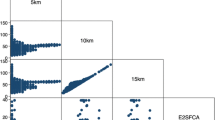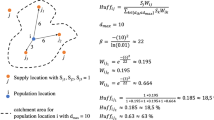Abstract
The inequitable geographic distribution of health care resources has long been recognized as a problem in the United States. Traditional measures, such as a simple ratio of supply to demand in an area or distance to the closest provider, are easy measures for spatial accessibility. However the former one does not consider interactions between patients and providers across administrative borders and the latter does not account for the demand side, that is, the competition for the supply. With advancements in GIS, however, better measures of geographic accessibility, variants of a gravity model, have been applied. Among them are (1) a two-step floating catchment area (2SFCA) method and (2) a kernel density (KD) method. This microscopic study compared these two GIS-based measures of accessibility in our case study of dialysis service centers in Chicago. Our comparison study found a significant mismatch of the accessibility ratios between the two methods. Overall, the 2SFCA method produced better accessibility ratios. There is room for further improvement of the 2SFCA method—varying the radius of service area according to the type of provider or the type of neighborhood and determining the appropriate weight equation form—still warrant further study.
Similar content being viewed by others
References
Guagliardo MF, Ronzio CR, Cheung I, Chacko E, Joseph JG (2004) Physician accessibility: An urban case study of pediatric primary care. Health Place 10:273–283
O'Neill L (2003) Estimating out-of-hospital mortality due to myocardial infarction. Health Care Manage Sci 6:147–154
Fortney J, Rost K, Zhang M, Warren J (1999) The impact of geographic accessibility on the intensity and quality of depression treatment. Med. Care 37(9):884–893
Hadley J, Cunningham P (2004) Availability of safety net providers and access to care of uninsured persons. Health Serv Res 39(5):1527–1547
Lovetta A, Haynesa R, Sunnenberga G, Galeb S, (2002) Car travel time and accessibility by bus to general practitioner services: A study using patient registers and GIS. Soc Sci Med 55:97–111
McLaughlin CG, Wyszewianski L (2002) Access to care: Remembering old Lessons. Health Serv Res 37(6):1441–1443
Radke J, Mu L (2000) Spatial decomposition, modeling and mapping service regions to predict access to social programs. Geogr. Inform Sci 6:105–112
Luo W, Wang F (2003) Measures of spatial accessibility to health care in a GIS environment: Synthesis and a case study in Chicago region. Environment and Planning B 30(6):865–884
Center for Health Statistics, (2002) Inventory of Health Care Facilities and Services and Need Determinations, Hospitals and Associated Services, vol. 1, Parts I-V., Illinois Department of Public Health, Illinois
US Bureau of Census (2000) Census Summary File 1
Apparicio P, Shearmur R, Brochu M, Dussault G (2003) The measure of distance in a social science policy context: Advantages and costs of using network distances in eight Canadian Metropolitan areas. J Geogr Inform Decision Anal 7(2):105–131
Wang F (2005) Measuring distances and time. In Wang F, Albert DP, Albrecht J (eds.) Quantitative Methods and Applications in GIS, Chap. 2, CRC Press, Boca Raton, FL
Guagliardo MF (2004) Spatial accessibility of primary care: Concepts, methods and challenges. Int J Health Geogr 3(3):1–13
Wang F (2005) GIS-based measures of spatial accessibility and application in examining health care access. In Wang F, Albert DP, Albrecht J (eds.) Quantitative Methods and Applications in GIS, Chap. 5, CRC Press, Boca Raton, FL
Guptill SC (1975) The spatial availability of physicians. Proc Assoc Am Geogr 7:80–84
United States General Accounting Office (2004) Medicare dialysis facilities: Beneficiary access table and problems in payment system being addressed, June
Author information
Authors and Affiliations
Corresponding author
Rights and permissions
About this article
Cite this article
Yang, DH., Goerge, R. & Mullner, R. Comparing GIS-Based Methods of Measuring Spatial Accessibility to Health Services. J Med Syst 30, 23–32 (2006). https://doi.org/10.1007/s10916-006-7400-5
Received:
Accepted:
Issue Date:
DOI: https://doi.org/10.1007/s10916-006-7400-5




